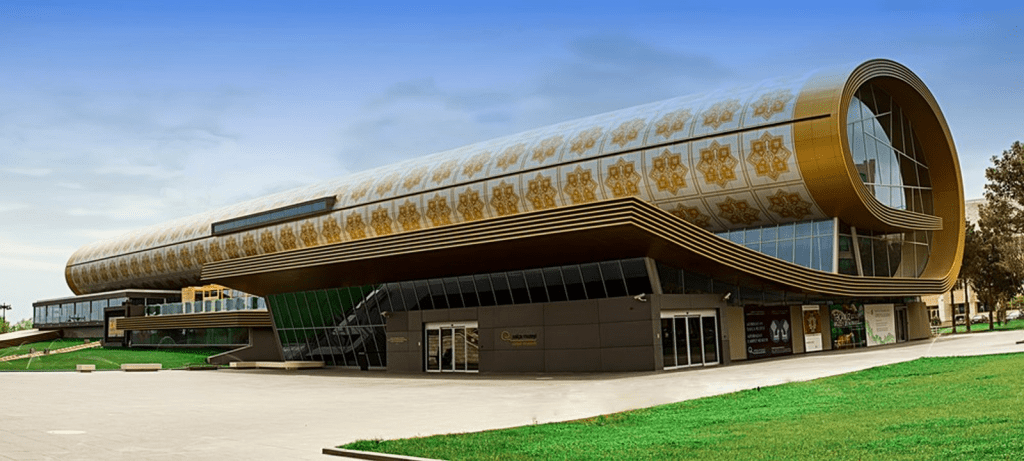
Azerbaijan Carpet Museum
The history of establishment of the Azerbaijan theatre has started from the first half of XIX century when the performances of the Azerbaijan public puppet theater became very popular. The first performances were organized in Shusha (1848) and Lankaran (1850). The year of 1873 may be named the birth date of the national theatre. On 22nd of March, i.e. the day of celebrating the ancient national holiday Novruz Bayrami, the comedy of Mirza Fatali Akhundov “Hadji Gara” was put on stage in Baku. Thus, the initiative of amateur theatrical troupe of the Baku real school was realized. The great assistance to the future idols of public at that time was rendered by the well-known Azerbaijani educator and publicist Hasan Zardabi, who considered the theatre to be a strong lever of people’s development.
In 1883 the famous oil magnate and patron of art Zeynalabdin Tagiyev constructed the building of the theatre – the real one, in European style, with beautiful stage and wide hall. It exist till now – The Azerbaijan Academic National Theatre of Drama. After a while the theatrical centers one after another appeared in Shusha, Nakhchivan, Gandja and other cities of Azerbaijan. Today the performances, based on motifs of the works of not only Azerbaijani, but also many foreign play wrights, are put on stages of the Theatre of Opera and Ballet, the Theatre of Russian Drama, the Musical Comedy Theatre, the Young Spectator’s Theatre, etc.
Museum business in Azerbaijan is radically connected to the history of development of the national applied art. Creativity of numerous national masters – skilled craftsmen long since has drawn attention of experts from Russia, Europe, and Asia. One of the most important and widespread branches of the applied art of Azerbaijan was manufacture of original carpets decorated with bright design and embroidery. At the beginning of XX century in the Caucasian handicraft committee there existed an art department, dealing in gathering of sketches and photographing of rare works of folk art, as well. Experts of committee made collections of carpet designs, searched for the unique ancient carpets, oriental carpets, khurdjunes (a kind of knitted bags), sumakhs, chuvals (a kind of big bag), and also silk “kelagai” (shawls), gold and beaded sewing, knitted stuffed scarves and shawls, wicker products. These collections, executing at the beginning strictly professional service functions, in due course have turned to exhibits of popular trade and aesthetic exhibitions, and then were typified as the museum treasures. At the beginning of 1914 the first Museum of Household Industry Products has opened, many of which were exhibited at the Berlin exhibition one year earlier. A part of this collection today can be admired in the Azerbaijan Carpet Museum. Along with the beautiful carpet-makers, the Azerbaijani jewelers, gun-makers, chasers, stone-cutters, are also widely-known, and their traditions are continued by their followers in XXI century.

Kelagai is a traditional Azerbaijani women’s headgear. It is a square-shaped silk head scarf with special prints on it.

Khurdjune. Travelling bag. Kilim technique. 19th century

The Shirvanshah’s Palace
The Shirvanshah’s Palace – a masterpiece of the Azerbaijani architecture, has been built in the beginning of XV century. It is one of the finest monuments of the Middle Ages. It is named the symphony, which has stiffened in a stone, the pearl of the Caspian Sea.

The Maiden’s Tower
The south-east part of the Baku fortress, opposite to National Park, there is one of the most ancient buildings of Baku – the Maiden’s Tower (Gyz Galasi). The inscription, which has been still kept on the Tower, tell us, that the Tower has been built not later than the XII century. The Tower has 8 floors and is 28 meters high. In 1964 the Maiden’s Tower became a Museum, and in 2000 it was included in the List of Monuments of the world heritage of UNESCO. Every year on April, 18 the Museum celebrates the World Day of monuments and sights.
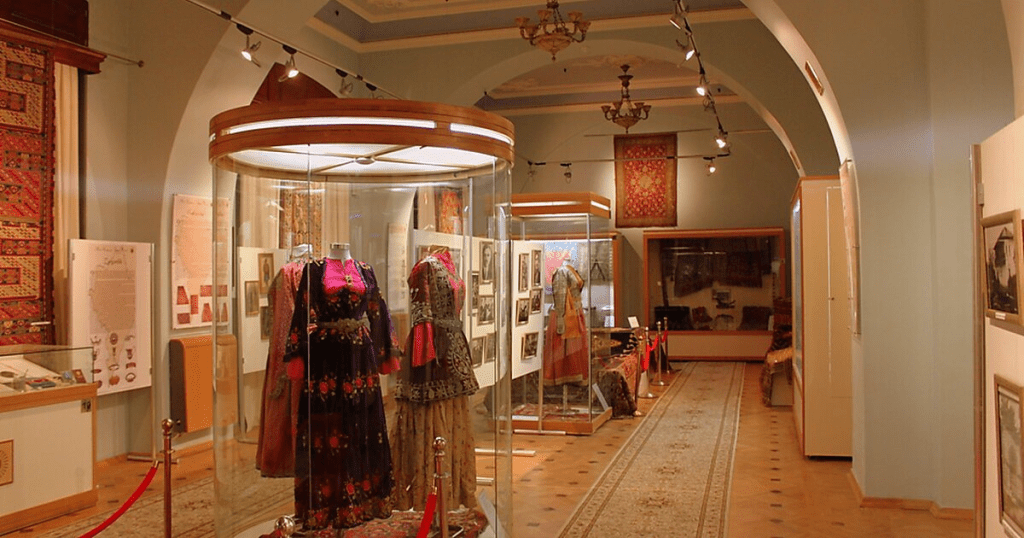
Museum of History of Azerbaijan
Museum of History of Azerbaijan, founded in 1920 is one of the biggest museums in Transcaucasia. The building where the Museum is located has been constructed in 1896 and belonged to the famous oil tycoon Haji Zeynalabdin Tagiyev. Over 250 thousand exhibits are collected in collections and reserves of the Museum. The exposition of the museum, displayed in 36 halls, acquaints visitors with the ancient, medieval, new and the newest history of the country.

Museum of the Azerbaijan Literature named after Nizami
In one of the central streets of the city there is a beautiful architectural building – the Museum of the Azerbaijan Literature named after Nizami. The memorial Museum was founded in 1939, in connection with 800 Anniversary of the famous Azerbaijani poet Nizami Gandjevi (1141-1209). The exposition of the Museum is demonstrated in 23 halls. In spacious halls you’ll make a fascinating travel on centuries and familiarize with a creative heritage of the great classics of the Azerbaijani literature Nizami, Fizuli, Vagif, Nasimi, Khagani, Mirza Fatali Akhundov, Jaffar Jabbarly, Jalil Mammadguluzade. Over 76 thousand exhibits are kept currently in reserves of the Museum.

Museum of Arts named after R. Mustafayev
Museum of Arts named after R. Mustafayev, the exposition of which has been opened for the first time in 1937, is the center of the artistic life of Baku. The rich collection of masterpieces of the fine arts, samples of Azerbaijani, Russian and West European art, the art of the Eastern countries, Turkiye, Iran, Japan, China is collected in the Museum. The big value is represented by the handmade carpets, well known far outside Azerbaijan. There are 12 thousand exhibits in 42 halls of the Museum. The originals of Dupree, Kaulte Fritz August, the products of the best porcelain factories of France, Germany of XVIII-XIX centuries, graceful figurines, antique sculptures, cloths, engravings and faience are demonstrated in Italian, German and French halls.

Azerbaijan State Museum of Musical Culture
The first data on musical culture of Azerbaijan concern to VIII millennium B.C.. Today the Museum of Musical Culture of Azerbaijan total over 35 thousands exhibits. The unique ensemble of 14 performers who play on medieval eastern musical instruments has been created in the Museum. These instruments are called gobuz, chogur, chang, barbet, rud, cheganeh, Shirvan tambur, rubab. They could be seen only in this Museum. Both medieval music and the Azerbaijani national songs, mughams, which can be heard within the precincts of the Museum every Thursday, are included in the repertoire of ensemble.

Museum of Carpet and Applied Arts
The Azerbaijani carpet art differs by its rich variety of the compositions, numbering over 600 kinds. In 1967, for the first time in the world the Azerbaijan Museum of Carpet and Applied Arts, named after the people’s artist Lyatif Kerimov, has been established. The carpets weaved in XVIII-XX centuries in Shirvan, Garabagh, Guba, Lahidj, Gazakh, Gandja and Apsheron districts of Azerbaijan, stored in collections and reserves of the Museum, are distinguished by their high quality and technique of production. Carpets, weaved in Garabakh area in XVI-XIX centuries, are exhibited nowadays in Berlin Museum, New-York and other famous museums of the world.

The National Academic Dramatic Theatre
The National Academic Dramatic Theatre was founded in 1873. The classical plays of M.F.Akhundov “Haji Gara”, “Monsieur Jordan” were successfully performed at its stage. For the first time the tragedies of W. Shakespeare “Othello”, “Hamlet”, “King Lyre”, the drama “Brigands” by F.Shiller, the comedies “The Revisor” by Gogol, “Skapen’s Tricks” by Molier have been staged there in the Azerbaijani language.
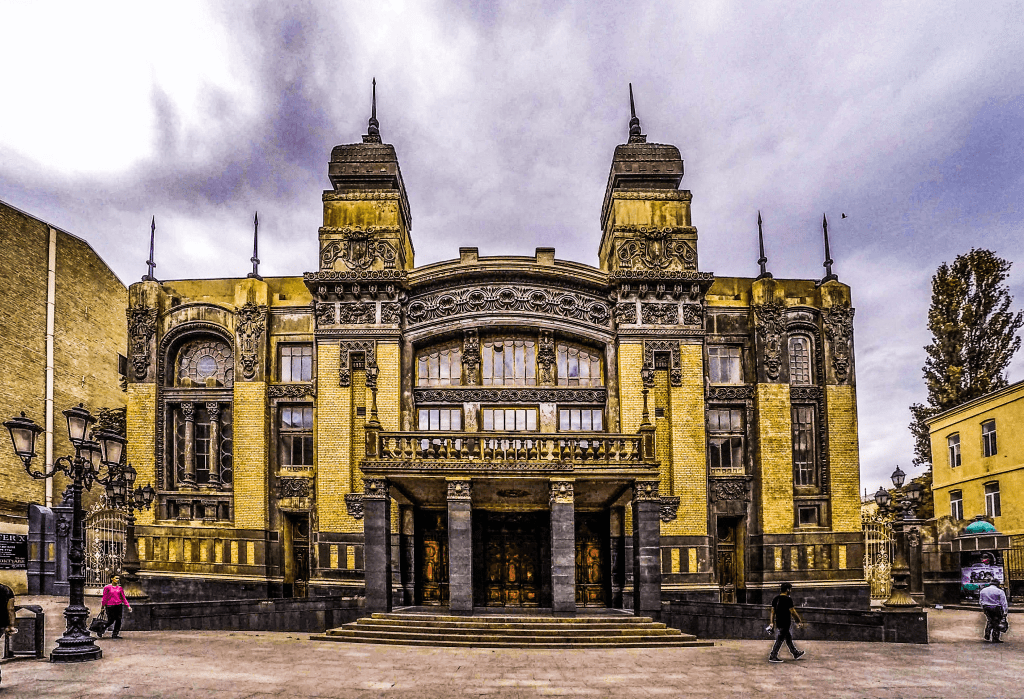
Opera and Ballet Theatre named after M.F. Akhundov
There is a beautiful architectural building in the center of Baku. It is Opera and Ballet Theatre, which is one of the centers of the cultural life of Azerbaijan. The building was constructed in 1910 by engineer Bayev. The Azerbaijani and foreign performances, such as “Aida” and “Traviata” by J. Verdi, “Tosca” and “La Boheme” by G. Puccini, “Carmen” by J. Bize, “Pagliacci” by Leoncavallo, “The Swan Lake” and “Shelkunchik” by P. I. Chaykovskiy, “Giselle” by Adan, “Leyli and Majnun”, “Koroglu” by Uzeir Hajibekov, “Sevil” and “1001 night” by F. Amirov, “Shah Ismayil” by M. Magomayev, “The Maiden’s Tower” by A. Badalbeyli, etc. are included in the repertoire of the Theatre. The famous soloists, conductors, directors from foreign countries are invited for participation in performances of the Theatre.

The Russian Dramatic Theatre named after S. Vurgun
The Russian Dramatic Theatre was created in 1920 and at once became one of the most popular theatres in Baku. The repertoire of the Theatre consists of the plays of classical, modern Azerbaijani and foreign dramatic art: “Chayka” by A. Chekhov, “Strange Mrs Savage” by D. Patrick, “Vazir of Lankaran khanate” by M. F. Akhundov, “We’ll meet on Torgovaya” by V. Neverov, “I pay in advance” by T. Ptushko, “The Russian show in Singapore” by A. Galkin, “Smart in love” by L. de Vega, “The Oil boom smiles all” by M. Ibragimbekov.

Theatre of Musical Comedy named after Shikhali Gurbanov
Theatre of Musical Comedy was created in 1938. The first musical comedy has been put on the Azerbaijani stage in 1910, it was “The Husband and the Wife” by Uzeyir Hajibekov. The world glory won the musical comedy of Uzeyir Hajibekov “Arshin mal alan”, which was screened three times and with success bypassed the theatrical stages of the Near East, Europe, America. The theatre attracts spectators not only by the high level of performances, but also by rich repertoire. Its basis is made with operettas “Silva”, “Maritsa”, “Gipsy-premier” by I. Calman, “The Merry Widow” by F. Legar, “The Violent Gascon” by K. Karayev.
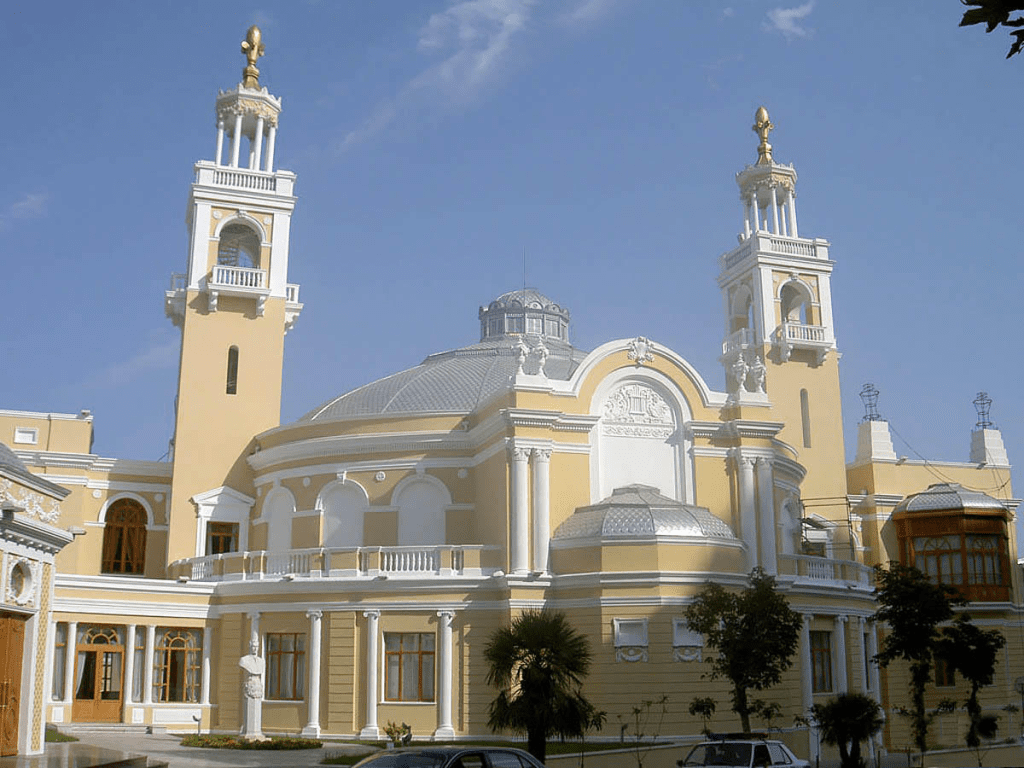
Philharmonic Society
The State Philharmonic Society was established in 1936 under the initiative of Uzeir Hajibekov. The State choral chapel, Orchestra of national instruments, Ensemble of national dance were founded under the umbrella of the Philharmonic Society. The Philharmonic Society being the pride of Baku, is the center of propagation of classical and folk music. The deserved collective of republic the Ensemble of song and dances, the choral chapel, the symphonic orchestra enjoy great popularity. The orchestra frequently acts together with the outstanding foreign performers and conductors. Actors of the Philharmonic Society successfully go on tour to the countries of Europe, Asia and Africa. In the spring of 2004, after restoration, the Philharmonic Society – unique monument of architecture of XIX centure – has appeared in all the former greatness and again has opened wide the doors for all amateurs of music.

Theatre of Young Spectator
Theatre of Young Spectator has been established in 1928. During its activity the troupe has visited with performances Russia, Uzbekistan, Turkmenistan, all cities and regions of Azerbaijan. Theatre of Young Spectators performs the plays specially written for children of junior, middle and senior age. The theatre has carried out over 500 performances both in the Azerbaijani, and in the Russian languages. In its creativity the collective achieves new success.

Puppet Theatre named after A. Shaig
The Puppet Theatre is located in the territory of National Park. This oldest architectural building with big interest is visited not only by children, but also by adults. The theatre has been founded in 1931 by M. Bebirly, one of the representatives of romanticism. The repertoire alongside with children’s performances includes also performances for adults. With great success have passed the festival performances of the theatre in Iran, Turkiye, Yemen, and Russia.

Song Theatre named after R. Behbudov
Song Theatre, created in 1964 by the great master of stage, People’s artist Rashid Behbudov, today carries the name of its founder. Being one of the creators of a classical direction in the vocal performing art of Azerbaijan, developing traditions of high singing culture of “khanende” and characteristic style features of the Italian school, the great master has created the original and unique style. And at present the special place in repertoire is occupied by ancient national songs, mugams, tesnifs, the variety program, performed up today in the specific traditions, incorporated by great singer R. Behbudov. In 2000 the creative group of the theatre was part of the delegation representing Azerbaijan in Germany at EXPO-2000 Exhibition (Hannover). In 2001-2004 the actors of the theatre went on tour in Turkiye, France, Germany, Austria, Russia, representing the country within the framework of Day of culture of Azerbaijan.

Pantomime Theatre
Theatre of Pantomime has gone down to the history of theatrical art of the Azerbaijan Republic quite confidently. Despite of novelty of this theatrical form in Azerbaijan, admirers of a theatrical art have understood and have accepted a pantomime. Its founder is the honored worker of art of the Azerbaijan Republic Bahtiyar Khani-zade. Since 1994, the theatre has taken part at festivals of pantomime in a number of the countries: France, Germany, Austria, Holland, Bulgaria, Turkiye, Iran, Russia, Ukraine, Georgia.
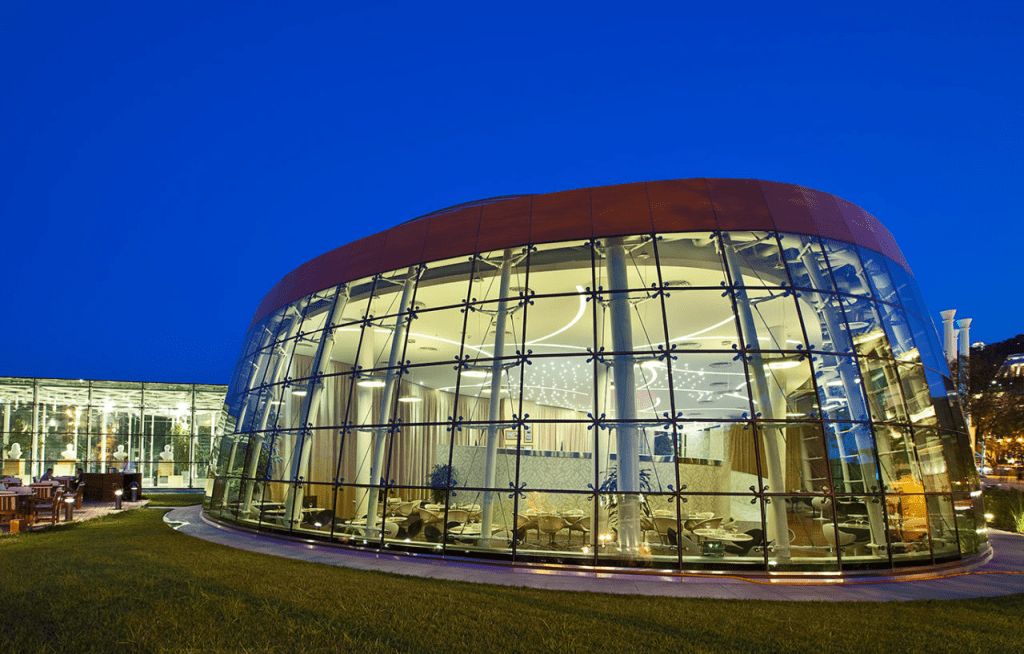
Mugam Center
The Mugam Center of Baku was founded in 1997 as the first state museum dedicated exclusively to Azerbaijani music. It is one of the most impressive musical and cultural heritage complexes in the region and is a major feature of Baku’s tourist attractions. The center was built in order to save and consolidate Azerbaijan’s musical culture and at the same time convey it to a wider audience. The center is chaired by Larisa Alakhverdova and houses two permanent exhibitions. The first permanent exhibition is dedicated to the history of the Mugam music, from its origins to its current forms. The second exhibition displays a range of musical instruments, including gosha naghara drums, tar and kamancha. During the museum’s festivals, held in spring and autumn, the center offers traditional performances by musicians from different regions of Azerbaijan. The Mugam Center of Baku has also organized numerous international projects, such as the first pan-Asian Mugam festival in 2004. In 2017, the center partnered with the Silk Road Project to produce a CD containing a selection of pieces from the repertoires of Azerbaijani and Central Asian players of traditional instruments. The center is also a research institute with the mission to carry out research on Azerbaijan’s musical heritage and to promote it in the world. To serve this purpose, it regularly organizes lectures and workshops, both with national and international experts. In 2018, the Mugam Center of Baku was awarded the status of a UNESCO Intangible Cultural Heritage Centre, which recognized its important role of preserving and promoting Azerbaijan’s musical heritage. With this honor, the center promises to continue to do its part to further promote and promote Azerbaijani culture.
SOURCE: MINISTRY OF CULTURE AND TOURISM


1 comment
Waooo So many theaters and beautiful theaters also .
Waooo Azerbaijan has soo much beautiful theaters.
I am pleased to see this really and I haven’t see such a beautiful theaters before really great.
Pakistan should also have such theaters same like Azerbaijan really then it would be a very enjoyable.
Comments are closed.